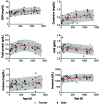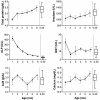Hematology and Clinical Chemistry Reference Intervals for Inbred Strain 13/n Guinea Pigs (Cavia Porcellus )
- PMID: 31010455
- PMCID: PMC6526494
- DOI: 10.30802/AALAS-JAALAS-18-000118
Hematology and Clinical Chemistry Reference Intervals for Inbred Strain 13/n Guinea Pigs (Cavia Porcellus )
Abstract
Inbred Strain 13/N Guinea Pigs are Frequently Used As Animal Models in Studies of Emerging and High-pathogenicity Viruses. To Date, Clinical Reference Intervals Have Not Been Established for Hematology and Clinical Chemistry Parameters in This Strain. We Obtained Whole-blood Samples from the Cranial Vena Cava of Healthy Strain 13/N Colony Animals for Inhouse Cbc and Clinical Chemistry Analyses. Analyte Values Were Investigated to Determine Subpopulation Differences According to Age and Sex. Glucose, Albumin, Alp, Lymphocyte Percentage, Hgb, and Mchc Decreased with Age, Whereas Neutrophil and Monocyte Percentages, Bun, Creatinine, Calcium, and Amylase Increased with Age. Total Protein and Wbc Counts Increased Over the First 300 D of Life Before Stabilizing. Across All Age Categories, Female Guinea Pigs Consistently Had Lower Rbc, Hct, Hgb, Alt, Alp, and Amylase Levels and Higher Mcv Values Than Males. These Trends Were Strongest in Adults (age, 151 Through 900 D). Most Parameters Stabilized by 300 D; Previous Studies Used 60 D or 120 D As Adult Age and 90 to 120 D As Sexual Maturity. We Recommend Age Group Definitions of 0 Through 150 D for Juveniles, 151 Through 900 D for Adults, and Older Than 900 D for Geriatric Adult Strain 13/N Guinea Pigs.
Figures






Similar articles
-
Age- and sex-associated differences in hematology and biochemistry parameters of Dunkin Hartley guinea pigs (Cavia porcellus).PLoS One. 2021 Jul 9;16(7):e0253794. doi: 10.1371/journal.pone.0253794. eCollection 2021. PLoS One. 2021. PMID: 34242236 Free PMC article.
-
Hematology and serum chemistry of harp (Phoca groenlandica) and hooded seals (Cystophora cristata) during the breeding season, in the Gulf of St. Lawrence, Canada.J Wildl Dis. 2006 Jan;42(1):115-32. doi: 10.7589/0090-3558-42.1.115. J Wildl Dis. 2006. PMID: 16699154
-
Age-related changes in haematology and serum chemistry of Weiser-Maples guineapigs (Cavia porcellus).Lab Anim. 2005 Jul;39(3):321-30. doi: 10.1258/0023677054307042. Lab Anim. 2005. PMID: 16004692
-
Clinical pathology reference ranges of laboratory animals. Working Group II, Nonclinical Safety Evaluation Subcommittee of the Japan Pharmaceutical Manufacturers Association.J Vet Med Sci. 1993 Jun;55(3):351-62. doi: 10.1292/jvms.55.351. J Vet Med Sci. 1993. PMID: 8357905 Review.
-
Hematological assessment in pet guinea pigs (Cavia porcellus): blood sample collection and blood cell identification.Vet Clin North Am Exot Anim Pract. 2015 Jan;18(1):33-40. doi: 10.1016/j.cvex.2014.09.002. Vet Clin North Am Exot Anim Pract. 2015. PMID: 25421024 Review.
Cited by
-
Comparison of two point of care lactate instruments in guinea pigs (Cavia porcellus).J Exot Pet Med. 2023 Jun;46:7-11. doi: 10.1053/j.jepm.2023.03.002. Epub 2023 Mar 16. J Exot Pet Med. 2023. PMID: 38894854 Free PMC article.
-
Age- and sex-associated differences in hematology and biochemistry parameters of Dunkin Hartley guinea pigs (Cavia porcellus).PLoS One. 2021 Jul 9;16(7):e0253794. doi: 10.1371/journal.pone.0253794. eCollection 2021. PLoS One. 2021. PMID: 34242236 Free PMC article.
-
ZOOMICS: Comparative Metabolomics of Red Blood Cells From Guinea Pigs, Humans, and Non-human Primates During Refrigerated Storage for Up to 42 Days.Front Physiol. 2022 Mar 21;13:845347. doi: 10.3389/fphys.2022.845347. eCollection 2022. Front Physiol. 2022. PMID: 35388289 Free PMC article.
-
Suboptimal Handling of Piccolo Samples or Reagent Discs for Consideration in Ebola Response.Emerg Infect Dis. 2019 Jun;25(6):1238-1240. doi: 10.3201/eid2506.181928. Epub 2019 Jun 17. Emerg Infect Dis. 2019. PMID: 30900978 Free PMC article.
-
Hematological profile of free-range Sunda porcupine (Hystrix javanica).Open Vet J. 2024 Sep;14(9):2415-2420. doi: 10.5455/OVJ.2024.v14.i9.30. Epub 2024 Sep 30. Open Vet J. 2024. PMID: 39553753 Free PMC article.
References
-
- Barthold SW, Griffey SM, Percy DH. 2016. Pathology of laboratory rodents and rabbits, 4th ed Ames (IA): Wiley–Blackwell.
-
- Bell TM, Shaia CI, Bearss JJ, Mattix ME, Koistinen KA, Honnold SP, Zeng X, Blancett CD, Donnelly GC, Shamblin JD, Wilkinson ER, Cashman KA. 2017. Temporal progression of lesions in guinea pigs infected with lassa virus. Vet Pathol 54:549–562. 10.1177/0300985816677153. Erratum in: Corrigendum. 2018. Vet Pathol 55:355 10.1177/0300985817753418 - DOI - DOI - PubMed
-
- Bird BH, Dodd KA, Erickson BR, Albariño CG, Chakrabarti AK, McMullan LK, Bergeron E, Ströeher U, Cannon D, Martin B, Coleman-McCray JD, Nichol ST, Spiropoulou CF. 2012. Severe hemorrhagic fever in strain 13/N guinea pigs infected with Lujo virus. PLoS Negl Trop Dis 6:1–13. 10.1371/journal.pntd.0001801. - DOI - PMC - PubMed
-
- Cashman KA, Smith MA, Twenhafel NA, Larson RA, Jones KF, Allen RD, 3rd, Dai D, Chinsangaram J, Bolken TC, Hruby DE, Amberg SM, Hensley LE, Guttieri MC. 2011. Evaluation of Lassa antiviral compound ST193 in a guinea pig model. Antiviral Res 90:70–79. 10.1016/j.antiviral.2011.02.012. - DOI - PMC - PubMed
MeSH terms
Substances
LinkOut - more resources
Full Text Sources
Medical
Research Materials

